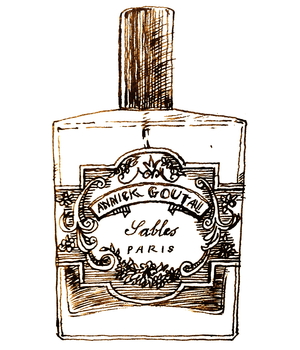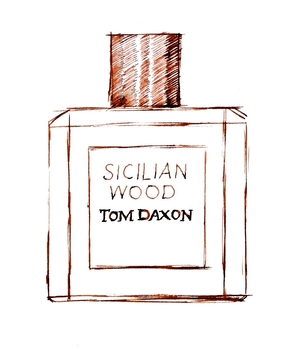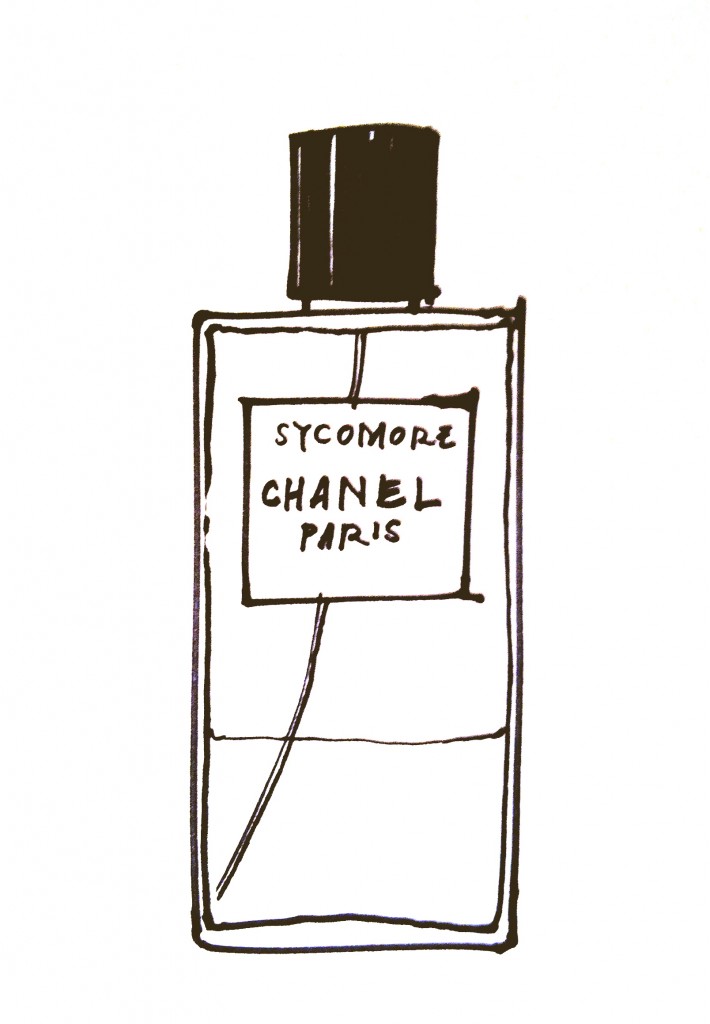Article Archive
Annick Goutal
Sables
5 February, 2015
 Once you’ve smelled a lot of perfumes you start to realise when a scent is cheap and nasty – even on the occasions when it’s got a huge advertising budget and everyone seems to be buying it. (Why? Well, a lot of people still get swept up by advertising, but you can be fairly sure they’ll only buy it once.)
Once you’ve smelled a lot of perfumes you start to realise when a scent is cheap and nasty – even on the occasions when it’s got a huge advertising budget and everyone seems to be buying it. (Why? Well, a lot of people still get swept up by advertising, but you can be fairly sure they’ll only buy it once.)
But even among the most brilliantly put-together perfumes each person’s individual reaction counts for a lot. Smell taps in to such deeply rooted – and often subconscious – memories and associations for each of us that two people can have completely different gut-reactions to the same scent.
And not only that: it actually smells completely different to each of them, even though their brain is presumably processing the same elements in a fairly similar way. Most scientists seem to agree that, unless we suffer from particularly severe sight problems, the way I see Hèrmes orange is almost certainly the same as the way you see it.
Smell, though, appears to work in a rather different manner. We may well smell the same scents in the same objective way, but the personal associations that specific scents have for us seem to be more powerful than what we actually smell – conceivably for the simple reason that we have such trouble describing them in words.
Here’s a perfect example. Sables was first launched by the late, great French perfumer Annick Goutal in 1985, and though it was withdrawn from the UK market some time ago in one of those mysterious overnight disappearances that give the perfume industry its faint whiff of Stalinism, it can still be bought online and abroad.
Sables is one of my all-time favourite fragrances. Though its name is meant to evoke the high-summer sexiness of sun-baked sand, this fantastically rich, sweetly luxurious scent smells, to me, of all the best things about Christmas – vintage oloroso sherry, mince pies, the delicious heat of an applewood log fire, flaming brandy, Christmas pudding… All very positive associations, as far as I’m concerned.
I’d be the first to admit that Sables is strong stuff, best suited to opulent winter evenings; apply it too liberally and, like Guerlain’s L’heure bleue or Chanel’s No22, it can easily become overpowering. But while I can imagine choking on No22 in too high a concentration, to be overcome by Sables would, for me at least, be like drowning in a butt of Malmsey – frankly not a bad way to go.
To a friend who knows at least as much about perfume as I do, though, Sables has an unattractively medicinal smell with none of the enchanting connotations that give it such a deep and lasting appeal for me. I can (kind of) see what he’s getting at, and if I try hard I can just about identify a hint of cough-mixture about it, but for some reason that association, in my mind, is completely drowned out by all the good stuff I’ve already mentioned.
The moral? I’m not sure there is one, but I guess it’s always good to remember there’s no guarantee that everyone is going to share your passion for a particular perfume, no matter how wonderful it smells to you.
Tom Daxon
Sicilian Wood
11 January, 2015
 I had high hopes of Sicilian Wood. Tom Daxon launched his perfume business in March 2013 at the age of 25, and has quickly gained a lot of fans. I’m not surprised, as he looks like a nice chap and he should know his stuff: his mother, Dale Daxon Bowers, was trained as a chemist and worked for Mary Quant cosmetics before becoming creative director of Molton Brown, so you could say that Tom grew up in the fragrance business.
I had high hopes of Sicilian Wood. Tom Daxon launched his perfume business in March 2013 at the age of 25, and has quickly gained a lot of fans. I’m not surprised, as he looks like a nice chap and he should know his stuff: his mother, Dale Daxon Bowers, was trained as a chemist and worked for Mary Quant cosmetics before becoming creative director of Molton Brown, so you could say that Tom grew up in the fragrance business.
He’s started out with a small range of nine different perfumes, and as you’d hope given his background they’re outstandingly well designed and packaged, with sharp typefaces, smart faceted bottles and attractive boxes cleverly secured with criss-crossing black ribbons.
So far so good. The only trouble is, try as I might I just can’t get to like the perfume inside.
Daxon compares Sicilian Wood with ‘a citrus grove warming in the sun… [with] an effervescent, hyper-real citrus top note [that] settles into a base of seductive woods.’ He’s also described it as ‘a budget-less woody citrus [that] will prove a revelation to anyone left underwhelmed by all the bland versions out there.’
I certainly get the citrus, and the warmth, which emerges from a mix of (among other things) cardamom, guaiac wood, jasmine, cedar and sandalwood. But Sicilian Wood also has to me an unsettling, slightly sickly, somehow faintly chemical smell, which it shares with so many men’s fragrances on the market (especially so-called ‘sports’ scents) that I call it cheapone: the very opposite of ‘budget-less’, in other words.
Whatever it is, it spoils this perfume for me, which is a shame, as I’d really like to like it, not least because it was created by Carla Chabert and her father Jacques, who was once assistant to the perfumer Henri Robert at Chanel, and is said to have had a hand in Chanel’s classic Cristalle. Time to explore some of the other perfumes in the range.
Chanel
Sycomore
28 May, 2014
 Until recently, Sycomore was one of the most extraordinary perfumes that I know (see note, below). OK, its name looks like a misspelling of sycamore, a tree that – in Britain at least – no right-minded person would name a fragrance after. Sycamores, after all, are as common as muck, breed like rabbits and are often looked down on by ecologists as they’re not even native trees.
Until recently, Sycomore was one of the most extraordinary perfumes that I know (see note, below). OK, its name looks like a misspelling of sycamore, a tree that – in Britain at least – no right-minded person would name a fragrance after. Sycamores, after all, are as common as muck, breed like rabbits and are often looked down on by ecologists as they’re not even native trees.
Acer pseudoplatanus, to give the tree its proper botanical name, is also responsible for many of those deeply irritating ‘leaves on the line’ excuses that railway companies give out each autumn to explain why their trains are running late. Worst of all, from a perfume perspective, they don’t even really smell of much, though their leaves do have the faintest leathery scent and their wood, once dried enough, burns with a pretty generic woodsmoke smell.
So is Sycomore just an example of misguided marketing, like Ralph Lauren’s dreadfully named Glamourous? Actually, no. Coming from arguably the world’s most tightly policed brand, its name will have been very carefully considered – and actually it almost certainly refers not, as I’d initially thought, to Acer pseudoplatanus at all but to a rather more exotic tree, the so-called Sycomore fig.
Ficus sycomorus (to use its Latin name) is a large, spreading tree that grows across central Africa and the Middle East, where its heavy shade is much appreciated; it was known to the Egyptians as the Tree of Life. It’s a tree I haven’t sniffed, but my guess is that it shares at least some of the dry, green, slightly fruity scent that we know from other varieties of fig – though ironically there’s only the faintest hint of figginess in Sycomore.
Anyhow, enough about the name. What makes Sycomore extraordinary, for me, is a trick it seems to be able to do that no other perfume I’ve come across seems to be able to do. This is to smell like two completely different scents, depending on whether you smell it close up or at a distance. Up close it has the strong, earthy, pleasantly bitter scent of vetiver, the root of an Indian grass that’s related to lemongrass and citronella. It’s also grown commercially in the Caribbean, and apparently Chanel’s super-high-quality vetiver originated in Haiti.
Vetiver is usually classed as one of the great masculine fragrances, presumably because of its bracing bitterness and lack of cloying sweetness; it’s certainly not a flowery smell. But it also has a warmth and – get this – a touch of smokiness that gives it extra depth and complexity, especially when it’s surrounded by such a delicious cushion of other scents, which mix smokiness with a slightly sweeter touch of fruit. Vetiver is also famous for its staying power, and a spritz of Sycomore can last you all day.
It’s the added fruitiness that, on occasion, one gets a whiff of when someone wearing Sycomore strolls by, and then it’s like a different, warmer, sweeter fragrance altogether, with hardly a hint of the vetiver that dominates the perfume on the skin. If it’s an intentional trick I’m in awe, though it seems perfectly possible, given that Sycomore was created by Chanel’s chief nose Jacques Polge in collaboration with Christopher Sheldrake, the legendary British perfumer who has been Chanel’s director of research and development since 2005.
Like the other fragrances that belong to Les Exclusifs de Chanel, Sycomore costs about twice as much as your average perfume, but it does come in a typically (for Chanel) handsome bottle, beautifully presented in a chunky white-and-black box. The hidden magnet in the heavy black cap, ensuring that the iconic twin Cs of the Chanel logo always end up perfectly aligned, is a particularly nice touch, even if it has since been adopted by one or two other brands.
Though it’s a classically masculine scent Sycomore is (quite rightly) marketed as a unisex fragrance, and like most men’s perfumes it can smell wonderful on a woman. Yet what I love most is that, from the very first sniff, it has a wonderful feeling of luxury, quality and depth, which are things that are all too often lacking in other perfumes. And who could resist its baffling cleverness, like a cryptic crossword in scent?
Autumn 2016 update. Oh dear: evidently Sycomore hasn’t been a commercial success, as Chanel have recently ‘updated’ it, and now – minus the fruitiness that made it so unusual – it’s a perfectly pleasant, fairly straight-up vetiver. From being unique it’s become one of many. Such a shame – another great perfume gone.